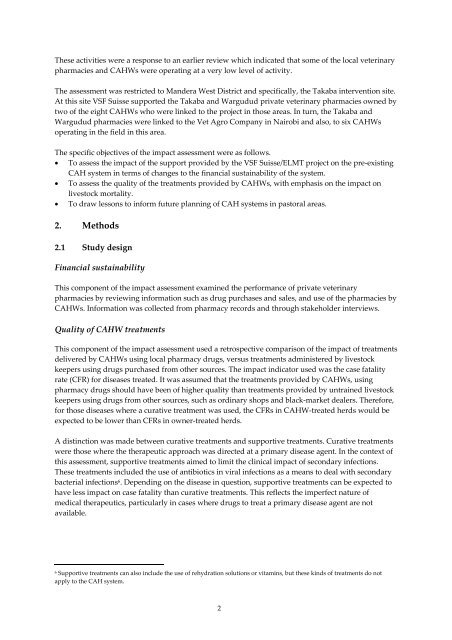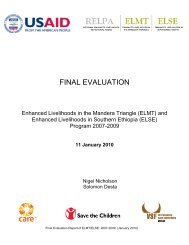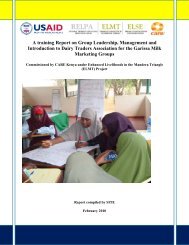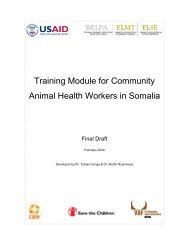Impact Assessment of the Community Animal Health System in ...
Impact Assessment of the Community Animal Health System in ...
Impact Assessment of the Community Animal Health System in ...
You also want an ePaper? Increase the reach of your titles
YUMPU automatically turns print PDFs into web optimized ePapers that Google loves.
These activities were a response to an earlier review which <strong>in</strong>dicated that some <strong>of</strong> <strong>the</strong> local veter<strong>in</strong>ary<br />
pharmacies and CAHWs were operat<strong>in</strong>g at a very low level <strong>of</strong> activity.<br />
The assessment was restricted to Mandera West District and specifically, <strong>the</strong> Takaba <strong>in</strong>tervention site.<br />
At this site VSF Suisse supported <strong>the</strong> Takaba and Wargudud private veter<strong>in</strong>ary pharmacies owned by<br />
two <strong>of</strong> <strong>the</strong> eight CAHWs who were l<strong>in</strong>ked to <strong>the</strong> project <strong>in</strong> those areas. In turn, <strong>the</strong> Takaba and<br />
Wargudud pharmacies were l<strong>in</strong>ked to <strong>the</strong> Vet Agro Company <strong>in</strong> Nairobi and also, to six CAHWs<br />
operat<strong>in</strong>g <strong>in</strong> <strong>the</strong> field <strong>in</strong> this area.<br />
The specific objectives <strong>of</strong> <strong>the</strong> impact assessment were as follows.<br />
• To assess <strong>the</strong> impact <strong>of</strong> <strong>the</strong> support provided by <strong>the</strong> VSF Suisse/ELMT project on <strong>the</strong> pre‐exist<strong>in</strong>g<br />
CAH system <strong>in</strong> terms <strong>of</strong> changes to <strong>the</strong> f<strong>in</strong>ancial susta<strong>in</strong>ability <strong>of</strong> <strong>the</strong> system.<br />
• To assess <strong>the</strong> quality <strong>of</strong> <strong>the</strong> treatments provided by CAHWs, with emphasis on <strong>the</strong> impact on<br />
livestock mortality.<br />
• To draw lessons to <strong>in</strong>form future plann<strong>in</strong>g <strong>of</strong> CAH systems <strong>in</strong> pastoral areas.<br />
2. Methods<br />
2.1 Study design<br />
F<strong>in</strong>ancial susta<strong>in</strong>ability<br />
This component <strong>of</strong> <strong>the</strong> impact assessment exam<strong>in</strong>ed <strong>the</strong> performance <strong>of</strong> private veter<strong>in</strong>ary<br />
pharmacies by review<strong>in</strong>g <strong>in</strong>formation such as drug purchases and sales, and use <strong>of</strong> <strong>the</strong> pharmacies by<br />
CAHWs. Information was collected from pharmacy records and through stakeholder <strong>in</strong>terviews.<br />
Quality <strong>of</strong> CAHW treatments<br />
This component <strong>of</strong> <strong>the</strong> impact assessment used a retrospective comparison <strong>of</strong> <strong>the</strong> impact <strong>of</strong> treatments<br />
delivered by CAHWs us<strong>in</strong>g local pharmacy drugs, versus treatments adm<strong>in</strong>istered by livestock<br />
keepers us<strong>in</strong>g drugs purchased from o<strong>the</strong>r sources. The impact <strong>in</strong>dicator used was <strong>the</strong> case fatality<br />
rate (CFR) for diseases treated. It was assumed that <strong>the</strong> treatments provided by CAHWs, us<strong>in</strong>g<br />
pharmacy drugs should have been <strong>of</strong> higher quality than treatments provided by untra<strong>in</strong>ed livestock<br />
keepers us<strong>in</strong>g drugs from o<strong>the</strong>r sources, such as ord<strong>in</strong>ary shops and black‐market dealers. Therefore,<br />
for those diseases where a curative treatment was used, <strong>the</strong> CFRs <strong>in</strong> CAHW‐treated herds would be<br />
expected to be lower than CFRs <strong>in</strong> owner‐treated herds.<br />
A dist<strong>in</strong>ction was made between curative treatments and supportive treatments. Curative treatments<br />
were those where <strong>the</strong> <strong>the</strong>rapeutic approach was directed at a primary disease agent. In <strong>the</strong> context <strong>of</strong><br />
this assessment, supportive treatments aimed to limit <strong>the</strong> cl<strong>in</strong>ical impact <strong>of</strong> secondary <strong>in</strong>fections.<br />
These treatments <strong>in</strong>cluded <strong>the</strong> use <strong>of</strong> antibiotics <strong>in</strong> viral <strong>in</strong>fections as a means to deal with secondary<br />
bacterial <strong>in</strong>fections 6 . Depend<strong>in</strong>g on <strong>the</strong> disease <strong>in</strong> question, supportive treatments can be expected to<br />
have less impact on case fatality than curative treatments. This reflects <strong>the</strong> imperfect nature <strong>of</strong><br />
medical <strong>the</strong>rapeutics, particularly <strong>in</strong> cases where drugs to treat a primary disease agent are not<br />
available.<br />
6 Supportive treatments can also <strong>in</strong>clude <strong>the</strong> use <strong>of</strong> rehydration solutions or vitam<strong>in</strong>s, but <strong>the</strong>se k<strong>in</strong>ds <strong>of</strong> treatments do not<br />
apply to <strong>the</strong> CAH system.<br />
2












